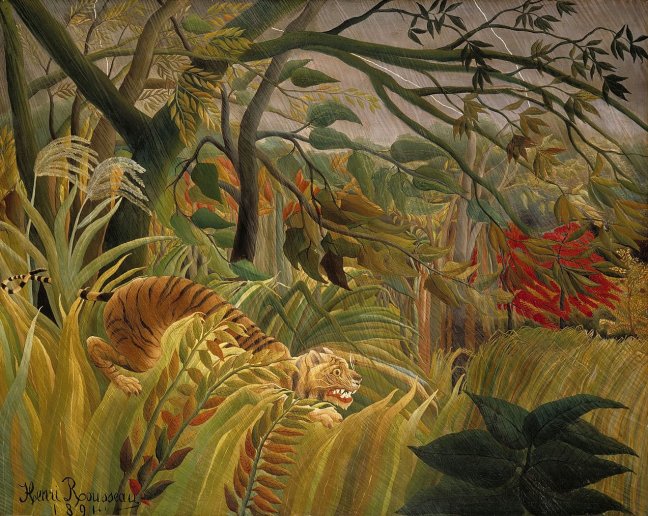
When I first visited the National Gallery in London during the summer of 2013, I instantly fell in love with the entire place. The architecture of the gallery was exquisite and its contents fascinated me; the absolute attention to detail and the countless amount of hours that used to go into old and traditional paintings truly struck a chord with me. Painters loved their art, and they dedicated their lives to their passion. Amongst the idyllic Monet paintings, my friend Orla dragged me over to this painting, and it resonated with me more than any other canvas I’d seen.
Surprised!, an 1891 oil-on-canvas painting by Henri Rousseau personally symbolises an array of different modern day issues to me despite being created over 100 years ago. Rousseau’s title ‘Surprised!’ matched with the tiger’s petrified expression first of all expresses to me the appalling hunting trade that still continues today, reducing many species to near extinction. It feels as if I as the viewer am a poacher and the subject of the painting is cowering in complete fear upon sight of me. Even today, tigers are being hunted for use in traditional medicine, pushing them to become members of the endangered species list. Even more devastating to read is the fact that the UK are still a part of this trade, making me feel like I’m attacking the subject even further and evoking a feeling of genuine sorrow.
The second metaphor I see within this painting is one for mental health. The angle of the trees, branches and grass present chaotic winds, the rain only contributing to the relentless attack and the presence of lightening creating a loud, auditory tone for the painting. Personally I find this to represent the sheer terror associated with a panic attack, with the tiger’s face representing the emotions one may feel in the presence of such an attack. The environmental factors combined with the characteristics of the tiger all interact with one another to produce an overall sense of complete surrender. The painting is beautifully sensory and I find that when I take my time to delve into each individual aspect I can see the painting’s relation to anxiety and panic disorders.
What I truly find beautiful about this piece is that despite it being formed over 100 years ago, it still finds a place in modern day issues today. When focussed on, it has the ability to transport its viewers to the scene of the piece itself, something I find to be a sign of successful art – whether this be writing, music, or paintings themselves.

